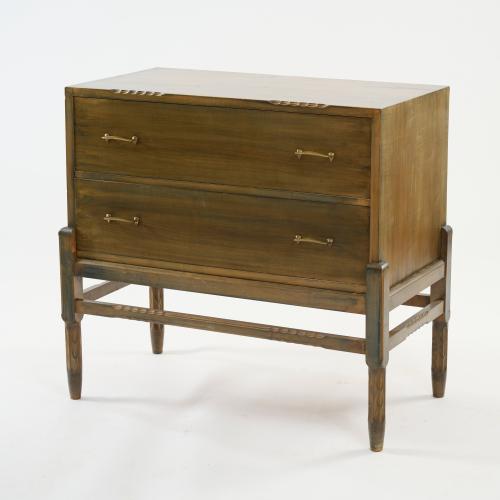Biography
Born in Münster in 1872, Bernhard Pankok first completed an apprenticeship with the painter and sculptor Heinrich Fleige, then with the decorative painter and restorer Heinrich Dieckmann. Thanks to funding from another former teacher, he was able to transfer to the Royal Prussian Academy of Art in Düsseldorf in 1889. In the fall of 1891, he went to Berlin at the instigation of his patron, and just one year later he completed his training in Munich as a self-taught artist in his own studio.
As a graphic artist, Pankok designed the German catalog for the 1900 Paris World's Fair. From 1895, he published his work in the magazine “Pan” and from 1896 in the magazine “Jugend”.
Through the Swiss painter and architect Hans Eduard von Berlepsch-Valendas, he met Hermann Obrist, Bruno Paul and Paul Riemerschmid, among others, who founded the “Vereinigte Werkstätten für Kunst im Handwerk” in 1896. This developed into the Deutscher Werkbund in 1907.
Pankok realized his first furniture as early as 1896 and took part in the VII. International Art Exhibition in the Munich Glaspalast in 1897. The music room he designed, which was shown at the 1904 World Exhibition in St. Louis and is now in the Württemberg State Museum, became famous. In 1901, King Wilhelm II planned a similar promotion of art in Württemberg, following the successful example of the Mathildenhöhe in Darmstadt, in order to stimulate the local economy. Attached to the School of Arts and Crafts, a third training center was founded, the Royal Training and Experimental Workshops. After being appointed director of this new institution on September 2, 1901, Bernhard Pankok initially began work together with Franz August Otto Krüger. The workshops were regarded as the first state institution in Germany to combine theory and practice in the decorative arts.
On October 15, 1913, the “Königlich Württembergische Kunstgewerbeschule” (Royal Württemberg School of Arts and Crafts) moved into the new building at Weißenhof, which Pankok had helped to build. From this point on, the training was broadened for everyone, with a focus on workshop instruction in addition to drawing lessons and art history studies. A total of eight subject areas were taught, including interior design and furniture making, book craft, decorative painting and textiles. After the First World War, further specialist areas such as arts and crafts photography, glass processing, machine knitting and fabric printing were incorporated into the institution, which was now known as the “State School of Arts and Crafts”.
To mark the school's 25th anniversary, a widely acclaimed anniversary exhibition was held from July to September 1927, which ran parallel to the Werkbund exhibition “Die Wohnung”.
Pankok died in Munich-Baierbrunn in 1943.
Objects by Bernhard Pankok
-
In the post auction sale

Bernhard Pankok Kunstgewerbeschule Stuttgart, Möbelwerkstätte
Chest of drawers, 1907
Reserve price: 1,000 €
